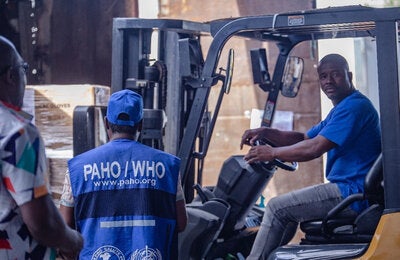
It is estimated that, thanks to vaccination, the Region of the Americas has already eliminated mother-to-child transmission of hepatitis B.
Washington, DC, 27 July 2020 (PAHO)- The Pan American Health Organization (PAHO) today urged that countries maintain essential prevention and treatment services for viral hepatitis during the COVID-19 pandemic so as not to jeopardize progress towards its elimination.
“In the midst of a pandemic, viral hepatitis continues to sicken and kill thousands of people,” said PAHO Director, Carissa F. Etienne. “Services, including vaccination against hepatitis B, are essential and cannot be stopped. Care must continue safely for all those who need it,” she added.
In the Americas, 3.9 million people live with chronic hepatitis B, and 5.6 million live with hepatitis C. However, a model developed by WHO estimates that 17 countries in the region have already managed to eliminate mother-to-child and early childhood transmission of hepatitis B, and that the Americas as a whole has also achieved the goal of less than 0.1% prevalence of hepatitis B in children under the age of 5.
PAHO/WHO recommends that all newborns are vaccinated against hepatitis B at birth and subsequently receive at least 2 additional doses to be protected for life. “With universal vaccination, we are creating new generations free from hepatitis B and moving towards eliminating hepatitis as a public health problem,” said Etienne.
World Hepatitis Day is celebrated every 28 July to raise awareness of viral hepatitis, which causes inflammation of the liver and can lead to cirrhosis and liver cancer. This year, the theme of the day is “Hepatitis-free future”. The focus is on the prevention of mother-to-child transmission of hepatitis B.
Over 90% of new, chronic hepatitis B infections occur from mother-to-child transmission or between children during early childhood. It is therefore essential that newborns and infants are vaccinated against hepatitis B within the first 24 hours of life. In the Americas, 31 countries (representing over 95% of newborns – around 14 million) recommend universal vaccination at birth and all countries and territories of the Region (51) vaccinate against hepatitis B in their routine vaccination programs. Regional vaccination coverage is over 80%.
Following the introduction of the hepatitis B vaccine more than two decades ago, the Americas is the Region of the world with the lowest prevalence of chronic infection. “The progress achieved is exemplary,” said the Director of PAHO. It is estimated that in 30 years, the region managed to reduce the prevalence of hepatitis B in children under the age of 5 from 0.7% to less than 0.1%, compared to the global average of 0.9%.
“These results would not be possible with the commitment of governments, health personnel and families to vaccinate,” said Etienne. However, the PAHO Director also warned that routine vaccination rates have recently decreased in some countries. She emphasized that efforts should be made to ensure that vaccination of newborns against hepatitis B occurs during the first 24 hours of life and that vaccination coverage of children under the age of one must remain high.
The estimated prevalence of hepatitis B in the general population is also lower in the Americas (0.7%) when compared to the world average (4%). While older generations did not benefit from childhood vaccinations, countries offer vaccination against hepatitis B to populations such as health personnel and at-risk groups. In the absence of a cure for people infected with hepatitis B, early diagnosis helps substantially prevent the risk of progression to cirrhosis and liver cancer, and access to treatment can control the infection.
Currently, there is no vaccine against hepatitis C, but antivirals can cure more than 95% of those infected. However, only 14% of infected people in Latin America and the Caribbean are diagnosed and less than 1% receive treatment due to its high cost. Some countries in the Region have accessed direct-acting antivirals (DAA) – which can cure hepatitis C in three months or less – through the PAHO Strategic Fund, a mechanism that ensures quality, affordable access to this medicine. However, few currently use it.
In 2019, PAHO launched its Elimination Initiative to end more than 30 infectious diseases in the Region by 2030, including viral hepatitis. To achieve this, health systems must ensure access to testing and treatment for all people with viral hepatitis for those who need it, as well as preventative measures such as vaccination.
Contacts
Leticia Linn
Sebastian Oliel
Ashley Baldwin
mediateam@paho.org



